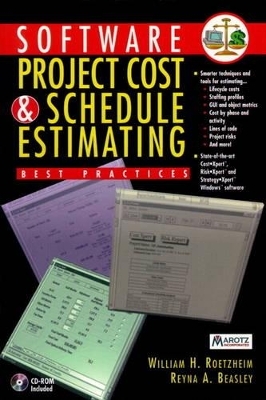
Software Project Cost and Schedule Estimating
Prentice Hall
978-0-13-682089-5 (ISBN)
- Titel ist leider vergriffen;
keine Neuauflage - Artikel merken
PLEASE PROVIDE ???
68208-8 Finally! Accurate software estimates and schedules! More projects are doomed by poor cost and schedule estimates than anything else. But it doesn't have to be that way. This book presents powerful, scientific techniques for confidently producing-and defending-accurate software development estimates and schedules. Leading software costing experts William H. Roetzheim and Reyna A. Beasley walk through every form of estimating: high-level estimates for feasibility planning; function-oriented estimates for procurement; and implementation-oriented estimates based on detailed designs. Discover better ways to measure lines of code and function points; new GUI and object metrics; and how to take advantage of "top down" and "bottom up" methods for smaller projects. Learn how to create outputs that include: *Lifecycle costs, including maintenance and support. *Staffing profiles. *Cost broken down by phase and activity. *Project risk profiles, and much more. You also get free evaluation copies of three world-class Windows-based software estimating and scheduling tools: Cost*ExpertaA A , Risk*ExpertaA A and Strategy*ExpertaA A .Calibrated using over 2,000 real-world projects, these tools can predict costs within 5%!
If you're a software engineer, developer, or manager, these tools and techniques will help you confidently predict what you'll need-and deliver what you promise!
1. Software Project Cost and Schedule Estimating.
Why Bother Estimating. The Estimating Life Cycle.
2. Estimating Program Value.
Fundamental Concepts Underlying Metric-Based Approaches. Estimating Lines-of-Code. Defining Modules. Installing Cost Xpert on Your Machine. Closing Applications Before Installing. CD-ROM Contents. Checking the Readme File. What the Installation Program Does. Customizing the Installation. Completing the Installation. Loading the Sample Project. Entering Estimates for Lines-of-Code. Viewing the Initial Results. Estimating Function Points. Estimating GUI Metrics. Estimating Object Metrics. Fundamental Concepts Underlying Heuristic Approaches. Bottom Up. Top Down. The Delphi Technique. Dealing with Code Reuse. Calculating the Equivalent Volume. Reuse in an Object-Oriented Environment. Correlating the Results.
3. Defining Your Project.
Project Identification Data. Selecting a Primary and Secondary Language. Selecting a Coefficient. Selecting a Software Development Standard. Commercial. DOD-STD-2167A. IEEE. MIL-STD-498. Defining Your Own Software-Development Standards. Selecting a Project Life Cycle. Defining Your Own Project Life Cycle. Defining Document Relationships. Selecting a Project Type. Entering Other Project Factors.
4. Adjusting For the Environment.
Value of Environmental Adjustments. General Approach to Adjusting for the Environment. Additional Uses of the Information. Team Experience Adjustments. Analyst Capability. Project Application Experience. Language Experience. Programming Team Capability. Virtual Machine Experience. Project Volatility Adjustments. Requirement Volatility. Virtual Machine Volatility. Project Characteristic Adjustments. Computer Turnaround Time. Data/base Size. Execution Time Constraints. Main Storage Constraints. Software Product Complexity. Required Software Reliability. Management Policy Adjustments. Modern Programming Practices. Required Reusability. Classified Application. Software Tools.
5. Time Sensitive Cost Modeling.
Optimal Project Staffing Curves. The Time/Cost Trade-Off. Avoiding the Impossible Region. Alternate Strategies for Accelerating Delivery. Reduce Functionality. Decouple Tasks. Use Redundant Parallel Development. Increase Reuse. Other Factors Influencing Project Schedule and Cost. Requirements Analysis Time. Beta Testing Time. Task Overlap. Review Time. Minimum Review Time.
6. Risk and Sensitivity Analysis.
Adjusting the Cushion. Adjusting Risk Tolerance. Likely Risk Factors. Performing a Sensitivity Analysis. Feeding Data to Risk Xpert.
7. Additional Cost Xpert Outputs.
Cost Allocations and Task Lists. Labor Loading by Phase and Category. Maintenance and Life-Cycle Costs. Software Maintenance Estimates. Software Defect Estimates. Support Calls. Deliverable Estimates.
8. Gathering Metrics, Tailoring Coefficients.
Tailoring Cost Xpert Curves. Modifying Alpha. Modifying Beta. Gathering Metrics. Tailoring the Coefficients.
9. Reducing Costs.
Cost Reduction, The Big Picture. Four Basic Cost Reduction Strategies. Some Silver Bullets. Adjusting Curve Coefficients in More Detail. Optimizing the Physical Environment. Optimizing the Mental Environment. Optimizing the Professional Growth Environment. Tracking Costs.
Appendix A. Quick Start Guide.
Starting Cost Xpert. Cost Xpert Main Window. Title Bar. Menu Bar. Status Bar. Application Screen Features. Tabs. Sub-Tabs. Grids. Scroll Bars. Drop-Down Menus. Radio Buttons. Buttons.
Appendix B. Menu Choices.
File Menu. File/Change Data Directory. File/Change Temp Directory. File/Export to Microsoft Project. Opening a File in Microsoft Project. Importing to Microsoft Project. Reports Menu. Maintain Menu. Maintain/Coefficients. Maintain/Project Life cycles. Maintain/Project Types, Likely Risks Sub-Tab. Maintain/Project Types, Likely Defects Sub-Tab. Maintain/Project Types, Likely Support Calls Sub-Tab. Maintain/Standards. Maintain/Activity-Document Relationships. Maintain/Programming Languages. Maintain/Test Data Integrity. Help Menu. Help/Contacting Marotz. Help/About.
Appendix C. Screen Reference.
Project Tab. Company Sub-Tab. Estimator Sub-Tab. Methods Sub-Tab. Financial Sub-Tab. Volume Tab. SLOC Sub-Tab, New Type. SLOC Sub-Tab, Reused Type. Function Points Sub-Tab, New Type. Function Points Sub-Tab, Reused Type. GUI Metrics Sub-Tab, New Type. GUI Metrics Sub-Tab, Reused Type. Object Metrics Sub-Tab, New Type. Object Metrics Sub-Tab, Reused Type. Bottom Up Sub-Tab, New Type. Bottom Up Sub-Tab, Existing Type. Top Down Sub-Tab. Environment Tab. Experience Sub-Tab. Volatility Sub-Tab. Project Sub-Tab. Policy Sub-Tab. Constraints Tab. Results Tab. Correlation Sub-Tab. Tasks Sub-Tab. Risk Sub-Tab. Labor Sub-Tab. Maintenance Sub-Tab. Deliverables Sub-Tab.
Appendix D. Reports.
Correlation. Tasks. Risk. Labor. Maintenance. Deliverables. Input Data. Input Data, General Data. Input Data, SLOC Data. Input Data, Function Points Data. Input Data, GUI Metric Data. Input Data, Object Metrics Data. Input Data, Bottom Up Data. Input Data, Top Down Data. All. Ad Hoc.
Appendix E. Risk Xpert.
Appendix F. HyperText Standards On-Line.
Appendix G. Strategy Xpert.
Appendix H. Glossary Terms.
Bibliography.
Index.
About the Software.
| Erscheint lt. Verlag | 10.12.1997 |
|---|---|
| Verlagsort | Upper Saddle River |
| Sprache | englisch |
| Gewicht | 337 g |
| Themenwelt | Informatik ► Office Programme ► Outlook |
| Mathematik / Informatik ► Informatik ► Software Entwicklung | |
| Wirtschaft ► Betriebswirtschaft / Management ► Finanzierung | |
| Wirtschaft ► Betriebswirtschaft / Management ► Projektmanagement | |
| ISBN-10 | 0-13-682089-1 / 0136820891 |
| ISBN-13 | 978-0-13-682089-5 / 9780136820895 |
| Zustand | Neuware |
| Haben Sie eine Frage zum Produkt? |